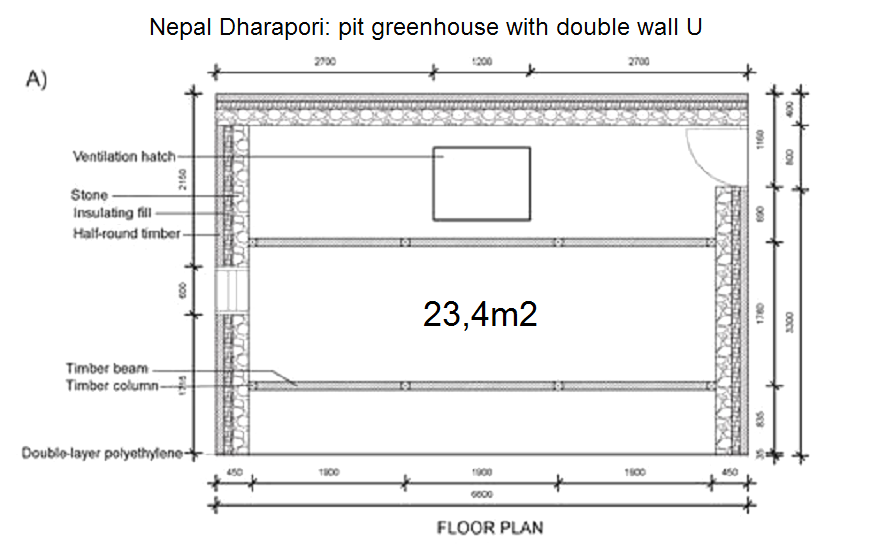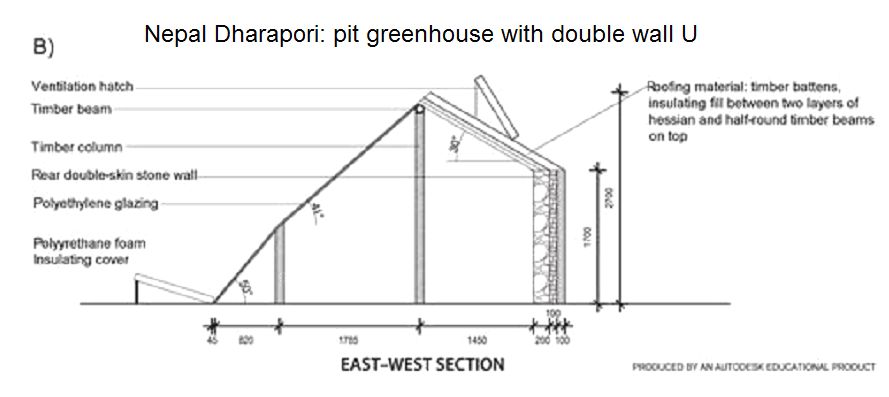D - ESP
"Walipini" 4d2: Dharapori (Nepal): Pit greenhouse on the surface with double wall U with more ventilation (RIDS 2008)
Fresh vegetables by a Walipini during summer and winter, evading long hikes, and more health and efficiency for mountain life
Live autarkic: NO pesticides - NO machines - NO long transports - NO overuse of water reserves in warm regions for plantations, etc.
LITTLE energy consumption - Mother Earth has got it!
presented by Michael Palomino (2022)
| Teilen / share: |
Facebook |
|
Twitter
|
|
|
|
Dharapori (Humla province, Nepal) 2008: Walipini greenhouse on the surface with double wall U with stone wall (RIDS 2008)
Web site of the NGO BioOne:
https://bioone.org/journals/mountain-research-and-development/volume-32/issue-4/MRD-JOURNAL-D-12-00057.1/Solar-Greenhouse-Technology-for-Food-Security--A-Case-Study/10.1659/MRD-JOURNAL-D-12-00057.1.full
In Dharapori, the NGO RIDS in Nepal was building a Walipini on the surface with a double wall U.
from the report ofRobert Fuller, Alex Zahnd :

Mr. Alex Zahnd from NGO RIDS [4] - logo of the NGO RIDS (Rural Integrated Development Services) [5]
[First, the solar greenhouse of the NGO HARS in Simikol is described. Then comes the description of the U greenhouse at Dharapori]:
Quote:
"A second solar greenhouse was built by RIDS-Nepal at their field station at Dharapori (2400 m altitude) in 2008 [photo 1]. The greenhouse was based on the GERES design, although with some adaptation; double-layer rock walls with [mud bricks with] an insulated cavity [in Ladakh] were substituted [by one stone wall, one insulation layer and a wooden shroud]. Corner flaps on the front face of the greenhouse and rear roof ventilators are opened to avoid overheating.
[Adaption and simplification of the Ladakh model in Dharapori]
Although this greenhouse performs satisfactorily, its size and cost are considered too great for a single Humla family. There is also scope to improve its thermal performance. These factors have prompted the development of a revised design that is more suitable for a single family. The plan view and E-W section of the greenhouse are shown in [photo 2+3]. The final size of the greenhouse is 6.6 × 4.5 m with a practical growing area of approximately 18 m2."

Nepal Dharapori: plan of the Walipini on the surface with double wall U (2008) [2]
Nepal Dharapori: cross section of the Walipini on the surface with double wall U (2008) [3]
Economic thoughts
[Long trails - no current - no basic data]
Humla province has no roads, only footpaths exist, and the challenges are gigantic. The villages are isolated with hours of mountain trails. There are no telephones or cell phones. Conditions in Humla were described by McKay et. al. (2007) [link].
Basic data on prices and incomes are virtually nonexistent because there is hardly any cash economy. Overall, vegetables are flown in by air from [the town of] Nepalgunj to Simikot in winter, so the prices for vegetables are increasing three times.
[The flight cost for vegetables in winter - the big cost of the greenhouse is the film - profitability with only 5-6kg of vegetables per year for 4 years].
[1 person only can manage a pit greenhouse better than a group]
The materials for pit greenhouses on the surface are available except the polyethylene film. According to the NGO RIDS-Nepal, the cost is 83 Nepal-Rupia (NR) per m2. THe costs for the air transportation for vegetables from Nepalgunj to Simikot are 135 Nepal-Rupia (NR) per kg. The distribution goes with animals or porters, and this is normally work without payment in the population. The film is UV protection, strong (120g/m2) and can last up to 6 years. A little pit greenhouse on the surface as it's shown on photo no.1 would need 55m2 of polyethylene film and the costs for that would be 5456 NR (about 65 "US" dollars).
The harvest in the pit greenhouse on the area depends on many factors. But these figures do suggest that just 5-6kg of vegetables per year is enough to recoup the cost [of the PVC film] within 4 years, similar to the greenhouses in Ladakh (Triquet undated [link]).
Quote:
"Vegetable output (kg) will vary, dependent on a multitude of factors. However, these figures indicate that an output of only 5–6 kg per year is required to achieve a payback of 4 years, similar to the greenhouses in Ladakh (Triquet undated)."
[Profitability - better health of the population - better efficiency - save time for trails]
In the HARS solar greenhouse in Simikot, experience has shown that over 80 kg of vegetables can be harvested per year. It is therefore estimated that a well-maintained and well-managed family-sized greenhouse in a village should be able to produce 30-40 kg [of vegetables] per year. Furthermore, the investment for better food security provokes improved health and economic profitability of the population [and the loss of time due to fine distribution on trails is also eliminated].
Quote:
"In the HARS solar greenhouse in Simikot, experience has shown that more than 80 kg of vegetables can be harvested each year. It is therefore estimated that a well-kept and well-managed family-sized greenhouse in a village should be able to produce 30–40 kg [of vegetables] per annum. The social benefits of improved health and food security would improve the economic viability of the investment."
Community acceptance
[Dozens of pit greenhouses in Humla district (Nepal)]
Quote:
"[The NGO] RIDS-Nepal has built 42 greenhouses in 10 villages of Humla over the past 7 years. Another six were constructed in one village in Jumla, a neighboring district. Approximately 25 of these are estimated to be still operating as intended. Another NGO has built some 20 more greenhouses based on the Dharapori design [with walls as an U, isolation layer, wooden shroud, and more ventilation] in 4 villages in the upper Humla region. Most (36) of the RIDS-Nepal greenhouses have been for individual use, the remainder being for community use with up to 10 families per community greenhouse. Due to the difficulties of conducting surveys in Humla, the following evaluation is based on the authors' collected anecdotal data and observations in the villages, rather than a comprehensive survey of users.
A community greenhouse, as expected, is much harder to establish and keep functioning well, compared with a family unit. The mutual trust required to operate and to harvest from the greenhouse is significant. It therefore usually takes some time for a community greenhouse project to be successful. If the tasks and benefits are not equally distributed, this will cause social tension and ultimately may lead either to the collapse of the project or result in only one person doing all the work and receiving the benefits. This was the outcome of one community greenhouse project in the village of Sata. In general, therefore, individually owned and managed greenhouses work better in Humla. However, despite this observation, some individual families have also failed to recognize the long-term benefits and their greenhouse has not been successful.
[Enthusiasm comes with the first winter with fresh vegetables]
In Humla, it has also been observed that sometimes there is a relative lack of enthusiasm for a greenhouse project in the first year of operation. For example, in Chala village (located at 3800 m altitude) vegetables are never seen during the cold winter season. However, after the first winter when some vegetables were available from the greenhouse, the villagers were much more enthusiastic. Thus, after the first winter experience with 2 greenhouses, the local people asked for more, and another NGO has now built a further 8 greenhouses. This illustrates that the initial hurdle of “disbelief,” and at times hesitation and/or fear of new inventions, has first to be overcome by results and once villagers have seen and eaten the produce, their motivation and enthusiasm is much greater. In this example, the second batch of greenhouses is already operating more successfully than the first 2 greenhouses did initially. It is important that attention is given to factors such as motivation, enthusiasm, the fear and/or hesitation about new developments, and more technical issues if greenhouse technology is to be implemented successfully.
[Additional agricultural formation in architecture and fertile soil care]
A long-term follow-up program to ensure that the greenhouse structure and the soil fertility are maintained is also vital to maintain user satisfaction. As mentioned, the “Family of 4 PLUS” program of RIDS-Nepal includes nonformal education and nutrition classes. These are based on the projects being implemented to ensure that their benefits are maximized."
Conclusion
Summary:
Solar greenhouses improve life for family and community in remote mountain areas in the Humla district (Nepal) with
-- food security
-- creation of new income
-- precondition is that the material costs are zero or low
-- and are locally available, and
-- labor is a community effort and free of charge.
Solar greenhouses in Humla [district] being operated by a family are more successful than those operated by a mixed group.
Education, training, and troubleshooting analysis are critical. Enthusiasm among the population increases with each success. The UN said that all mountain populations of the world should learn the technique of solar greenhouse, this is a livelihood in mountain regions.
Thanks
Quote:
"Thanks to Don Cullen of The Tibetan Village Project Australia for sharing his experiences and information about greenhouses built and operating in Tibetan villages. Alex Zahnd acknowledges the support of Murdoch University via an overseas PhD scholarship for some of the work presented in this article."
| Teilen / share: |
Facebook |
|
Twitter
|
|
|
|
Fresh vegetables by a Walipini during summer and winter, evading long hikes, and more health and efficiency for mountain life -- Dharapori (Humla province, Nepal) 2008: Walipini greenhouse on the surface with double wall U with stone wall (RIDS 2008) -- Web site of the NGO BioOne -- Adaption and simplification of the Ladakh model in Dharapori -- The new wall: layer of stones - isolation layer - wooden shroud -- In the night, the southern wall is covered from inside -- Air volume - irrigation - seeds - earth quality -- Economic thoughts -- Long trails - no current - no basic data -- The flight cost for vegetables in winter - the big cost of the greenhouse is the film - profitability with only 5-6kg of vegetables per year for 4 years. -- Profitability - better health of the population - better efficiency - save time for trails -- Community acceptance -- Dozens of pit greenhouses in Humla district (Nepal) -- 1 person only can manage a pit greenhouse better than a group -- Enthusiasm comes with the first winter with fresh vegetables -- Additional agricultural formation in architecture and fertile soil care -- Conclusion -- Thanks
Fotoquellen






^


